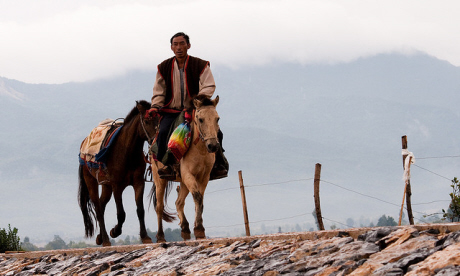
There are nearly 60 minority peoples in today's China. Amar Grover discovers how their unique cultures and traditions offer an insight into ancient lifestyles
So how,” I asked my guide, using flamboyant gestures and a dog-eared dictionary, “do we cross the river?”
Miming, he paused at the word for bridge, but then shrugged – it was hard to explain. I would just have to wait to see how we would cross.
I’d been staying in Shitoucheng, a spectacular village perched high above the Yangzi in Yunnan. This is Naxi heartland – a region of forested valleys, lofty mountains and, away from its modernising towns, the rustic allure of a more traditional China. Descended from Tibetan nomads, the Naxi have forged their own distinct culture. As a matriarchal society, women rule the roost.
They also do the cooking. At my simple lodgings the landlady had prepared banquet-sized feasts, which I wolfed down above a courtyard with sublime views. Small terraced fields laddered the deep, V-shaped valley, the great river coiled from north to south, and the Naxi toiled at their crops much as they would have done a century or two ago.
But we’d now left the village behind and, after hiking by cornfields and along steep green hillsides, our route across the river finally became clear. There was neither boat nor raft nor flying fox. Instead, a sagging water pipe was slung high above the river, rung-like wooden planks attached to it with wire. Cables served as handrails but they hung so low I ended up stooped forward with bent knees, holding on tight to counter the slight sway.
Safely across, I paused to congratulate myself and watch the traffic. Naxi women and children trotted across with ease. One sat next to me, lit her pipe and puffed contentedly while the sun dropped behind rugged hills.
The Naxi are just one of 55 ‘national minorities’ officially recognised by China, as distinct from the Han majority. Their numbers range from some 18 million Zhuang in south-central China to just a few thousand Derung near Burma. Recognition brings certain benefits, notably exclusion from the One Child policy.
With their distinctive clothes, customs, festivals and architecture these minorities represent China at its most diverse. One eye on the tourist dollar, their cultures are now generally encouraged. Minorities tend to live in some of the country’s most beautiful regions and borderlands where until recently relative isolation has helped preserve their integrity. Here are some of the most prominent, accessible and rewarding groups to visit.
Arguably the most distinctive of China’s minorities, the Uighur are China’s second most populous Muslim group, closely resembling their Central Asian cousins. Vast Xinjiang feels very different to the rest of China and travel here recalls the age of the Silk Road, with remote oases nourishing ancient trading routes. Highlights include Turpan, with its vine-covered streets and outlying ruined cities amid the desert, and Kashgar’s old quarter and celebrated Sunday Market. Between them, Kuqa offers a less touristy view of Uighur life, a vibrant Friday Market plus the picturesque though little-visited Kizil Thousand Buddha Caves.
Xishuangbanna, the far south-western part of Yunnan, reputedly harbours China’s greatest concentration of ethnic minorities, spread along the jungly borders with Burma and Laos. The Dai are the most populous – you can recognise them by the women’s bright sarongs, straw hats and silver belts and bangles.
One of the largest and most complex minority groups, the Miao are better known in Indochina as the H’mong, following migration there from China. Comprising an array of sub-groups partly defined by the style of their clothes, they are widely distributed across China’s south. Apart from everyday village life set in a rural idyll, the main focus of interest lies in their intricate embroidery and elaborate silver jewellery – shown to best effect during late winter and early spring festivals. Kaili town (Guizhou) is a good base for trips to nearby villages such as Langde, Xijiang, Taijiang and Shidong.
Believed to originate from northern Thailand, the Dong have lived in southern China for at least a millennium. Barely a century ago, many Dong were living poor and marginal lives in backwater regions; today they are famed for their beautiful drum towers and ‘wind and rain bridges’ – elaborate confections whose seats and shrines suggest they’re more than just a means to cross a river. Head for Chengyang (near Sanjiang in Guangxi) and nearby villages, or Zhaoxing village (in south-eastern Guizhou).
The old quarter of World Heritage-listed Lijiang is an appealing cluster of gurgling canals and cobbled lanes. Naxi women wearing traditional blue bodices and sheepskin capes still play cards in the main Market Square and you can stay in charming hotels converted from courtyard homes. However, the town gets packed with Chinese tourists in July and August so avoid these months. Aim to visit some outlying monasteries (eg Yufeng and Wenbi) and villages (such as Baisha), which see far fewer outsiders. Longer trips could include Shigu (at the Yangzi’s celebrated ‘first bend’), remoter Shitoucheng and the well-known hike through Tiger Leaping Gorge (though a new road has spoilt its tranquillity).